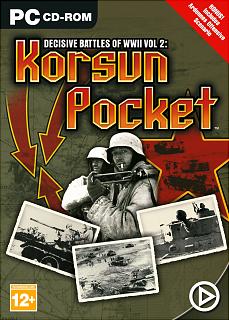Games Database
PC
Strategy: Combat
| Viewed: | 2D Static screen | Genre: | Strategy: Combat |
| Media: | CD | Arcade origin: | No |
| Developer: | Matrix | Soft. Co.: | Matrix |
| Publishers: | Just Play
(GB) |
Released: | 22 Aug 2003
(GB) |
| Ratings: | PEGI 12+ | ||
| No Accessories: | No Accessories | ||
Summary
Korsun Pocket is the long-awaited sequel to the groundbreaking wargame The Ardennes Offensive. Korsun Pocket uses a greatly improved version of The Ardennes Offensive engine to recreate the desperate German attempt to escape encirclement on the Russian Front early in 1944. The battle is a tense and exciting struggle, with neither side having a decisive advantage, as the Russians struggle to form the pocket, then try to resist successive German rescue efforts and last ditch attempts at breakout.
The game consists of a tutorial in which players learn the basics game functions, plus the ability to access either Korsun Pocket or The Ardennes Offensive. Each game is further subdivided into scenarios that focus on smaller parts of the battlefield with variable timeframes, as well as the ability to play 60 turn "Monster" games that will require many hours of playing time.
Korsun Pocket is played on a map overlaid with a hexagonal grid, on which are overlaid square "counters" with symbols representing the identity, type and combat strength of the historical military unit. Each counter usually represents units of regimental size. Players must manoeuvre their units, making best use of the terrain to attack and defend key locations to achieve the overall strategic objective.
In the Korsun Pocket, the strategic objective for the Soviet player is to eliminate a "bulge" or salient in their frontline caused by German troops occupying a bend in the Dniepr River. The German objective is to prevent this, but once it is obvious that the Soviets are deploying overwhelming forces, the objective is to get as many troops as possible out of harms way and to create a corridor through which the encircled forces can escape.
Both battles took place in winter and were influenced by horrendous weather conditions. Both battles were also influenced by logistics; for example, the Germans were short of fuel for their tanks, and in the Korsun Pocket, they were obviously cut off from supplies and could only be supplied by air.
The computer is used to take into account many different factors that would affect combat in WWII, and is designed to reward players for co-ordinating their forces in the same way the historical generals did. Players are awarded points for the casualties they inflict as well as for capturing and holding key objectives. This score will then be compared to historical achievement to determine the level of victory or defeat.
The game consists of a tutorial in which players learn the basics game functions, plus the ability to access either Korsun Pocket or The Ardennes Offensive. Each game is further subdivided into scenarios that focus on smaller parts of the battlefield with variable timeframes, as well as the ability to play 60 turn "Monster" games that will require many hours of playing time.
Korsun Pocket is played on a map overlaid with a hexagonal grid, on which are overlaid square "counters" with symbols representing the identity, type and combat strength of the historical military unit. Each counter usually represents units of regimental size. Players must manoeuvre their units, making best use of the terrain to attack and defend key locations to achieve the overall strategic objective.
In the Korsun Pocket, the strategic objective for the Soviet player is to eliminate a "bulge" or salient in their frontline caused by German troops occupying a bend in the Dniepr River. The German objective is to prevent this, but once it is obvious that the Soviets are deploying overwhelming forces, the objective is to get as many troops as possible out of harms way and to create a corridor through which the encircled forces can escape.
Both battles took place in winter and were influenced by horrendous weather conditions. Both battles were also influenced by logistics; for example, the Germans were short of fuel for their tanks, and in the Korsun Pocket, they were obviously cut off from supplies and could only be supplied by air.
The computer is used to take into account many different factors that would affect combat in WWII, and is designed to reward players for co-ordinating their forces in the same way the historical generals did. Players are awarded points for the casualties they inflict as well as for capturing and holding key objectives. This score will then be compared to historical achievement to determine the level of victory or defeat.







